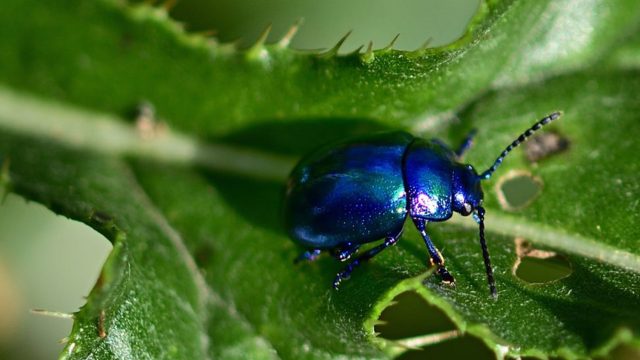Restoring the UK’s vital grasslands

UK grasslands are among the most diverse habitats in Europe. However, over the last 60 years there has been a drastic decline in the most valuable species-rich grasslands – upland calcerous grassland and hay meadows – due to increasingly intensive agriculture practices. More land given over to cattle grazing means fewer plant species, which has an impact on insect and animal communities – all of which could lead to a long-term change in the UK’s biodiversity.
Professor Paul Ashton’s three-year research into UK grasslands has looked at the link between plant biodiversity in these grassland habitats and its effect on invertebrate communities, and also on the success of schemes to restore Britain’s hay meadows.
“The aim of our research is to understand the natural world better through scientific analysis and then give that knowledge to the people who can make best use of it to improve biodiversity in the UK and beyond.”
Professor Paul Ashton
From local to landscape
Edge Hill’s work on hay meadows has not only had a positive impact on individual sites, it has also led to a 1% increase in hay meadow coverage nationally, improving biodiversity across the UK.
Focusing on invertebrates

Healthy plant diversity is thought to lead to a healthy population of other species, such as invertebrates like beetles and spiders, which are a vital part of the food chain. But is this always the case? Natural England wanted a scientific evidence base to determine whether managing grassland for plant diversity has a positive effect on the biodiversity of other species, such as invertebrates. This led to the development of the Upland Calcerous Grassland Project to look at the best way of managing grasslands to preserve or increase biodiversity.
The project found the link between plant diversity and other biodiversity is not as simple as previously thought. It found that a mix of low intensity sheep grazing, coupled with periods of no grazing, had the most positive impact on invertebrate populations as it allowed more varied vegetation to flourish which supported a wider range of invertebrates. This research has directly led to changes in management practice adopted by Natural England and The National Trust, the biggest landowners of Upland Calcerous Grassland, whose conservation efforts now consider the conservation of invertebrates separately to plants for the first time.
“Edge Hill’s research has enabled us to understand much better the impact of cattle/sheep grazing regimes on the vegetation and invertebrate communities. Specifically, the Edge Hill study looked at beetle and spider communities that hadn’t been assessed before, which was useful because it provided benchmark data against which any management changes can be assessed.”
Site Manager, Ingleborough National Nature Reserve, Yorkshire
Learning from the past

For the past 25 years, Agri-Environment Schemes (AES) have been in place to encourage land owners and farmers to farm in a way that supports biodiversity enhances the landscape, and improves the quality of water, air and soil.
Professor Ashton has been carrying out unique research on the UK’s herb-rich hay meadows – home to many species including pollinators – which have seen a 90% decline in the last 40 years. His work looks at the long-term success of AES on restoring hay meadows and the effects of different restoration approaches.
Professor Ashton found that where hay meadow restoration had been successful, the meadows had lost some of their individuality in terms of local species. By using donor hay from the same ‘model’ sites to restore failing sites, the species mix was becoming similar, so while they appeared to have been managed perfectly, they were actually losing species over time. This research was vital to the successful restoration of two sites in the Bowland Area of Outstanding Natural Beauty, which have reintroduced local species to hay meadows as part of their restoration.
Linking across the landscape

As well as helping to future-proof individual hay meadows, Professor Ashton’s work is also helping farmer and landowners see the bigger picture of meadow conservation.
Another strand of research set out to understand how interconnected hay meadows are, meaning are they sharing genetic material, through pollen or seed dispersal, between other hay meadows in the landscape or is activity restricted to single meadows or small areas? Greater connectivity between hay meadows gives species a better chance of survival as it allows positive mutations or adaptations to spread across areas, essential for surviving the effects of climate change in the future.
This work directly informed Lancashire Wildlife Trust’s restoration of grasslands within the Wigan Greenheart area, a network of canals, green spaces and woodlands established on derelict, ex-industrial land. Conservationists are now looking at the landscape as a whole, rather than focusing on individual sites, to ensure that species have the best chance of survival.
“The benefits to a range of wildlife have become clear… increasing the abundance of hay meadows and the connectivity between them in the North West.”
Site Manager, Wigan Greenheart Nature Improvement Area
Our research means that
- UK grasslands have a broader species mix and better connectivity within the wider landscape, ensuring their survival for future generations.
- Farmers understand how to farm in a way that is sympathetic to biodiversity and have evidence-based DEFRA policies in place to guide them.
- Conservation and land management organisations have greater insights into grassland management that can inform future conservation policy and practices and ensure invertebrate species are protected.
Find out more about Professor Paul Ashton’s research by viewing their profile on Pure:
Professor Paul Ashton’s research